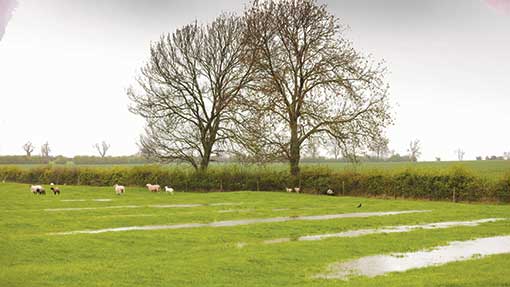Advice for grassland farmers on dealing with flooded fields after the water subsides

Farmers should resist accessing flooded fields too early or they could risk future grassland productivity, specialists are warning.
Once the water recedes there could be a temptation by many farmers to go on to the land too soon, which could cause surface compaction, says grassland expert Josephine Scamell.
“Farmers should have a calm attitude while the ground is still so wet. I have seen slurry being spread in waterlogged fields in recent days. It’s just crazy but unavoidable in some of these extreme situations,” says Ms Scamell, of Ground Level Nutrition.
Assessing the damage
To assess the extent of water damage, farmers should identify what percentage of pasture has survived by digging holes across a field to view the top 9-12in. This will enable a simple assessment of soil waterlogging, water percolation, earthworm activity, the health status of grass roots and the smell of the soil.
See also: latest flooding news
“It may sound surprising but many soils do actually survive flooding extremely well,” says Ms Scamell. “Soils with a good crumb structure and reasonable organic matter content will have been better able to maintain a ‘sponge’-type structure, which will allow for a more speedy recovery.”
Unhealthy soil will have a rancid chemical smell – a sign the soil is fermenting and not decomposing. There will be no earthworms. Soil should be crumbly to enable the movement of water and air, explains independent grassland consultant Gareth Davies.
Whether or not a field needs reseeding depends on how well the grass, in particular the grass roots, have survived long-term waterlogging. Mr Davies says: “Healthy roots will appear white and ‘alive’, while damaged roots will be brown.”
Aeration will introduce oxygen into the soil, essential for healthy root structure. It breaks up the physical barrier present in compacted soil, helping air and water to flow through, Mr Davies explains.
But in most situations, deep, flat-lift aeration will not be possible due to the extensive wet conditions. However, surface aeration with a vertical grassland slitter will be possible as surface conditions become drier. Vertical slits of between 6in and 8in will open up the surface cap without damaging roots structure.
But Ms Scamell reiterates fields should only be accessed when wheels don’t leave marks; where possible, machinery should be fitted with flotation tyres – although even these can cause surface compaction when used in fields too early.
Nutrients
When soil has been sitting under water, nutrients are likely to have leached out and therefore analysing the soil should be a priority. Calcium levels relating to pH are a major concern. Calcium may still be low even if the pH is within or above the target 6.3-6.5.
Ms Scamell says: “Quite often, flooded soils can become acidic. If this happens you may consider applying 2.5t/ha of calcium lime at the start of the growing season.”
In addition to the normal parameters of potash and phosphate, two important minerals to test for after flooding are sulphur and sodium. Low sodium levels can reduce the palatability of grass. Ms Scamell says applying natural granulated salt at 125-150kg/ha will help to overcome a deficiency.
Follow a how-to guide to assessing waterlogged pastures produced by EBLEX. View the guide and get more advice
